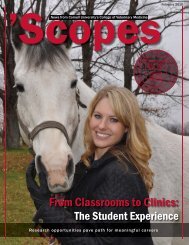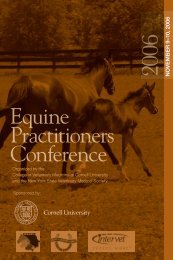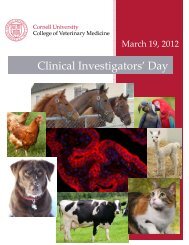2010 (PDF) - The College of Veterinary Medicine at Cornell University
2010 (PDF) - The College of Veterinary Medicine at Cornell University
2010 (PDF) - The College of Veterinary Medicine at Cornell University
You also want an ePaper? Increase the reach of your titles
YUMPU automatically turns print PDFs into web optimized ePapers that Google loves.
K<strong>at</strong>hleen O’Hara, <strong>Cornell</strong> <strong>University</strong>, Immunology<br />
Identifying a Genetic Marker for Equine Common Variable Immunodefi ciency<br />
<strong>Cornell</strong>’s Leadership Program brought together the best and brightest from around<br />
the world. Having just completed my fi rst year <strong>of</strong> veterinary school, I was fortun<strong>at</strong>e<br />
to share the insights <strong>of</strong> more senior students who had experienced entirely<br />
different cultures and learning experiences, yet were similarly motiv<strong>at</strong>ed to pursue<br />
nontraditional career routes. Together we explored the range <strong>of</strong> career options<br />
available to us, and I believe we gained confi dence in our own abilities to impact<br />
the future <strong>of</strong> veterinary science. <strong>The</strong> program confi rmed my desire to pursue a<br />
PhD, and interested me in exploring a clinical residency th<strong>at</strong> would enable me to<br />
grow pr<strong>of</strong>essionally. My goal is to be an academic clinical researcher.<br />
Under the direction <strong>of</strong> Julia Flaminio, I explored a high throughput transcriptome<br />
d<strong>at</strong>abase to identify candid<strong>at</strong>e genetic markers for equine common variable<br />
immunodefi ciency (CVID). Applying our knowledge <strong>of</strong> equine CVID, I used<br />
bioinform<strong>at</strong>ics tools to identify B-cell factor 1 (EBF1) as a potential target. Using<br />
cloning and sequencing techniques, I was able to establish a differential is<strong>of</strong>orm<br />
utiliz<strong>at</strong>ion p<strong>at</strong>tern <strong>of</strong> the EBF1 gene between CVID and healthy horses. In the<br />
future we hope to characterize the functional impact <strong>of</strong> this difference by focusing on the impacted protein domains<br />
and protein-protein interactions.<br />
I would like to thank the members <strong>of</strong> the Flaminio lab, especially Rebecca Tallmadge who guided my work this<br />
summer, for their interest and support during my summer experience. Additionally, I would like to wish all <strong>of</strong> my<br />
peers the best in their future pursuits.<br />
Ravee Padte, <strong>Cornell</strong> <strong>University</strong>, Genetics<br />
Wh<strong>at</strong> Can Transcriptome Sequencing Tell Us About Tame and Aggressive Foxes?<br />
When I began my DVM training in 2008, I was largely undecided as to my longterm<br />
career aspir<strong>at</strong>ions within veterinary medicine. I particip<strong>at</strong>ed in the Leadership<br />
Program to broaden my understanding <strong>of</strong> the unconventional avenues th<strong>at</strong><br />
veterinarians may take to improve animal and human health. I was also captiv<strong>at</strong>ed<br />
by the once-in-a-lifetime opportunity to work closely and build lasting rel<strong>at</strong>ionships<br />
with the best veterinary students from around the world.<br />
<strong>The</strong> Acland lab studies molecular mechanisms contributing to behavioral<br />
differences between strains <strong>of</strong> “tame” and “aggressive” silver foxes (Vulpes vulpes)<br />
developed by the Institute <strong>of</strong> Cytology and Genetics in Novosibirsk, Russia. Recently,<br />
the scientists utilized the Roche 454 FLX Titanium pl<strong>at</strong>form to sequence the frontal<br />
cortex transcriptome <strong>of</strong> one tame and one aggressive fox, and discovered over<br />
25,000 high-confi dence polymorphisms. In my project, I valid<strong>at</strong>ed over 30 singlenucleotide<br />
polymorphisms (SNPs) by designing primers th<strong>at</strong> targeted their loci,<br />
amplifying these regions with PCR, and sequencing the DNA via the traditional<br />
Sanger method. For one SNP th<strong>at</strong> changes an amino acid in a specifi c gene<br />
(PDGFRB), I conducted a popul<strong>at</strong>ion study to identify and confi rm differences in allele frequency between tame and<br />
aggressive foxes.<br />
I would like to extend my heartfelt thanks to Dr. Gregory Acland and his lab members, especially principal investig<strong>at</strong>or<br />
Dr. Anna Kukekova and Jennifer Johnson, for their enthusiasm in shaping my research experience. I wish my fellow<br />
scholars and Caleb Chan all the best in their pursuits. Lastly, I want to express my gr<strong>at</strong>itude to Drs. McGregor and<br />
Fraser for their wholehearted investment in the future <strong>of</strong> tomorrow’s veterinarians.<br />
To prepare tomorrow’s scientists and public health pr<strong>of</strong>essionals<br />
31








